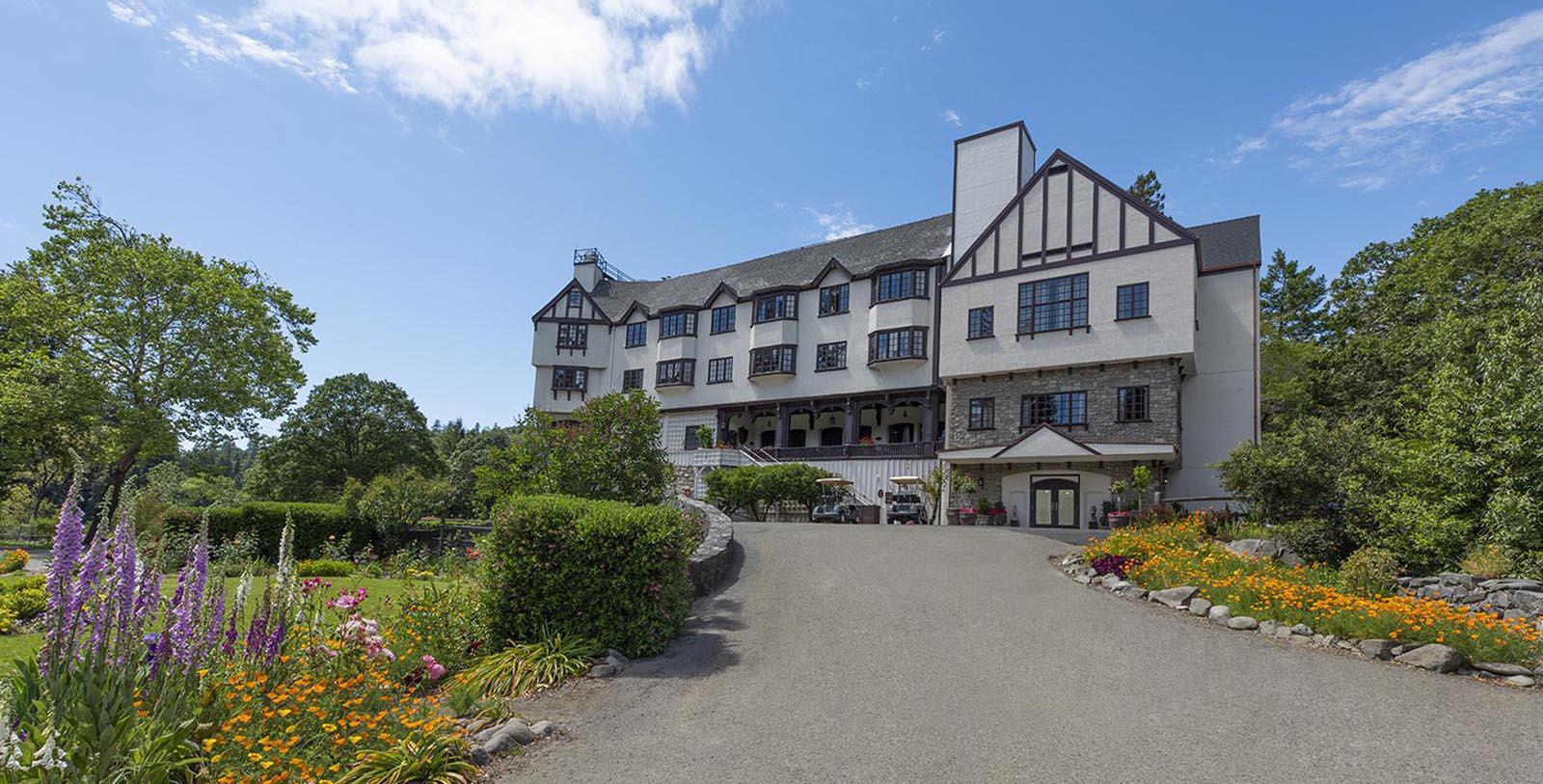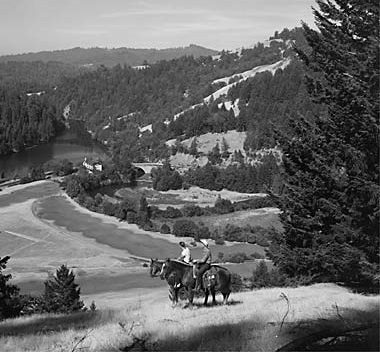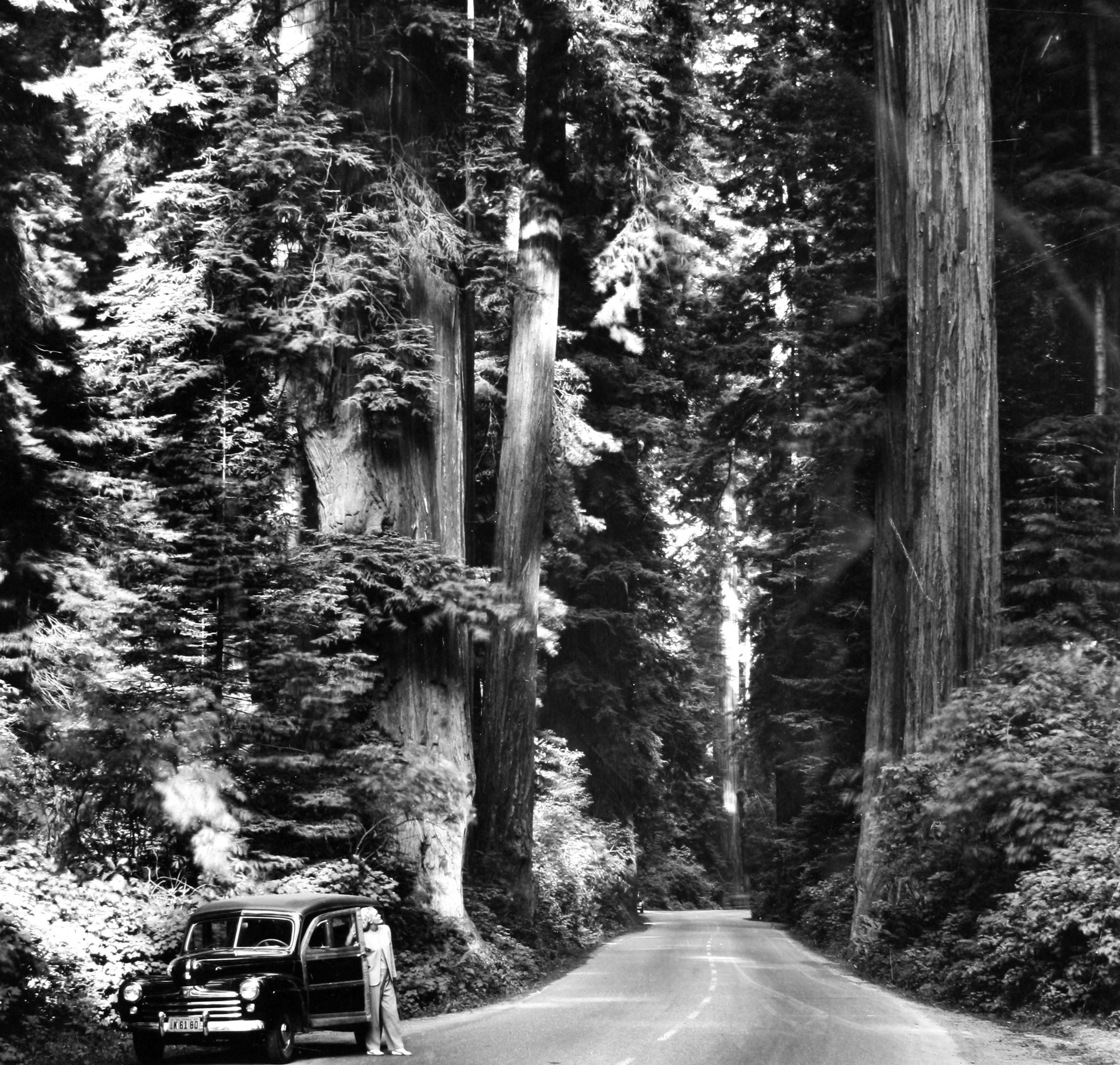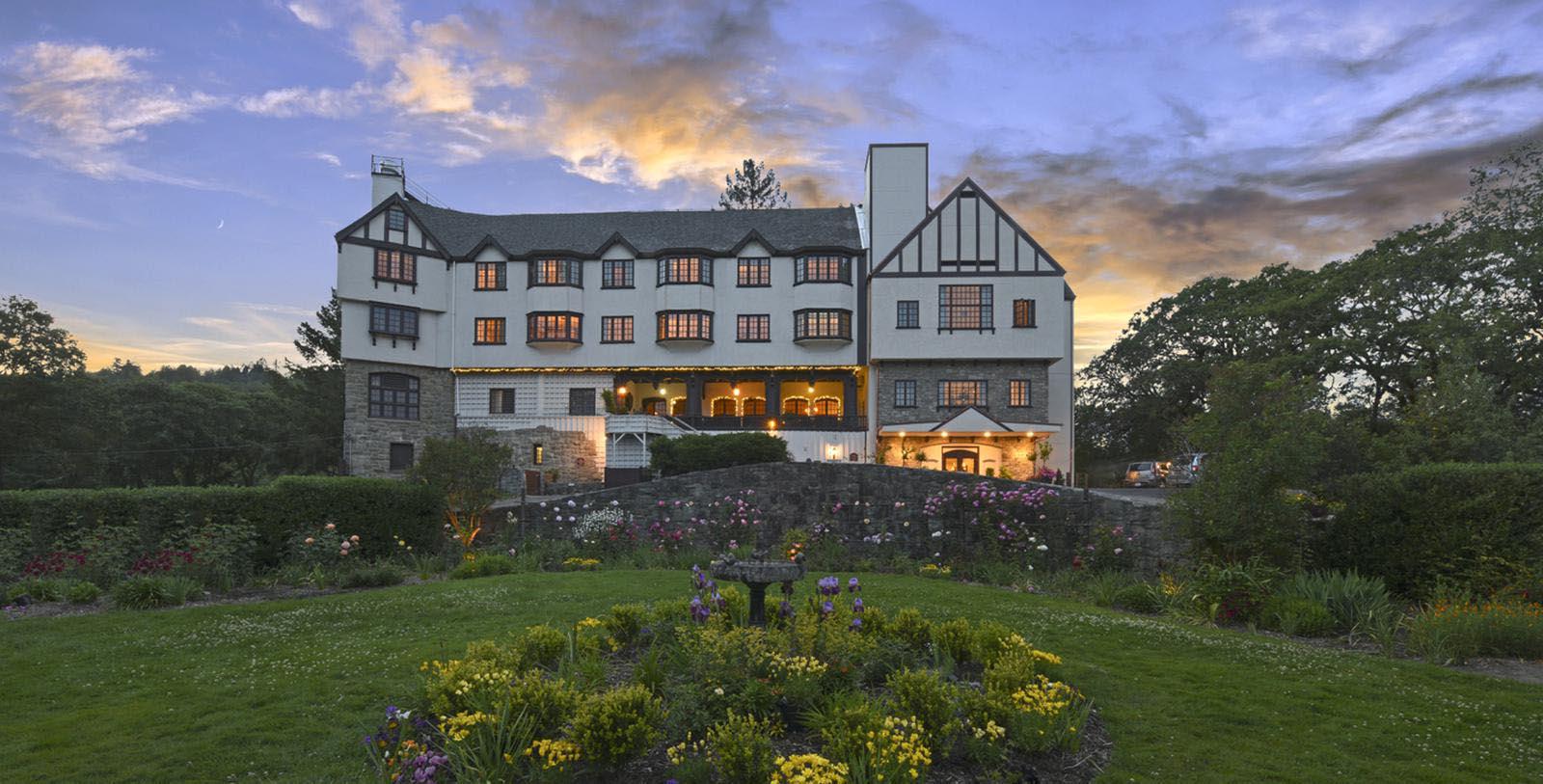Receive for Free - Discover & Explore eNewsletter monthly with advance notice of special offers, packages, and insider savings from 10% - 30% off Best Available Rates at selected hotels.
benbow inn history
Discover Benbow Inn, which was a destination for stars including Spencer Tracy, Clark Gable, Alan Ladd, Joan Fontaine, and Basil Rathbone.
A member of Historic Hotels of America since 2014, this location has been one of the most popular destinations along California’s Redwood Highway for close to a century. Benbow Inn history harkens back to the Benbow family, specifically nine brothers and sisters who had grown up in the surrounding environs of Humboldt County. The children of Arthur Benbow, those siblings were Joseph, Evangeline, Burtis, Clara, Helen, Jessie, Loleta, Walter and Robert. In 1924, the Benbows decided to purchase some 1,288 acres near the South Fork El River from Ernest Linser and a few other people. Together, they intended to develop a campground that their descendants could enjoy for generations. But as the neighboring Redwood Highway neared completion, the Benbows ultimately chose to erect a magnificent hotel close to the thoroughfare. The family subsequently hired noted San Francisco-based architect Albert Farr for the project, who was esteemed all over the Bay area for his use of various revivalist architectural forms. Perhaps his greatest piece of work to date was Jack London’s Wolf House in the vicinity of Glen Ellen. Using a brilliant blend of Tudor Revival-style architecture, Farr constructed a gorgeous wilderness retreat on behalf of the Benbows. But the family also created a picturesque golf course, a canoeing area, and several riding stables near the building. Electricity for the hotel even came from two diesel generators, until a dam and powerhouse opened on the Eel River a couple years later.
Originally called the “Hotel Benbow,” the Benbow family opened their business in the summer of 1926. Word spread quickly throughout California about the new hotel, thanks to the rising number of motorists traveling along the new Redwood Highway. As such, crowds of visitors from across the state felt inspired to venture into Redwood territory and reserve a guestroom. Soon enough, many of the nation’s most influential people made the trip north to stay at the Benbow’s tranquil vacation getaway. The names of Hollywood’s superstars appeared within the hotel’s guestbook, including the likes of Spencer Tracy, Clark Gable, Basil Rathbone, Alan Ladd, and Charles Laughton. Actress Joan Fontaine frequented the location on several occasions, too, using it to honeymoon with two different husbands. But the Hotel Benbow also attracted powerful politicians, such as former First Lady Eleanor Roosevelt and U.S. President Herbert Hoover. Yet, after operating the Hotel Benbow through the Great Depression and World War II, the Benbows sold their beloved business in 1962. A period of fluid ownership then followed, ending only when Chuck and Patsy Watts acquired the hotel nearly two decades later. The new proprietors lovingly restored the building, and through their efforts, the destination received a listing in the U.S. National Register of Historic Places in 1983. It was under their ownership that the inn was first awarded a Four-Diamond rating by the American Automobile Association, making it the only recognized full-service luxury hotel in Northern California for quite some time.
In 1994, John and Teresa Porter formed a partnership with Jack Macdonald to purchase the Hotel Benbow. The Porters themselves were already accomplished veterans of the hospitality industry, having worked in the sector for nearly half a century. They have continued to upgrade and restore the Benbow Inn, including extensive guestroom and terrace renovations that have cost some $600,000! More recently, the Porters invested heavily into making the building ADA compliant, installing such outstanding amenities like a five-stop elevator and a lower lobby check-in area. The latest construction work has also lead to the development of new public restrooms, accessible guestrooms, a stunning cocktail lounge, and two fantastic meeting rooms. But the renovations have also done much to protect the rich historical character of the hotel, ensuring that its fascinating architecture will endure for years to come. Now known as the “Benbow Inn,” the Porters have endeavored to preserve the business’ status as one of northern California’s most exclusive holiday destinations. In fact, their stewardship has resulted in the bestowal of several awards and accolades onto the hotel. Among the feathers in its proverbial cap have included winning numerous Awards of Excellence from Historic Hotels of America. In 2014, for instance, the Benbow Inn earned the title of “New Member of the Year,” while the business received “Best Small Historic Inn” four years later. Teresa Porter was even acknowledged as Historic Hotels of America’s “Historian of the Year” in 2018!
-
About the Location +
While Benbow Inn resides deep in redwood country, it is just a short drive from Garberville, California. Garberville is located in southern Humboldt County, which was once occupied exclusively by Native Americans many centuries ago. Among the tribes that called the area home were the Wiyot, the Yurok, and the Wailaki. But during the 1850s, the first settlers of European origin arrived in the area. Josiah Gregg led the expedition, seeking a path to San Francisco through Northern California’s verdant wilderness. Yet, the party eventually split when it reached the confluence of the Van Duzen and Eel rivers, fighting over which waterway to take back to the coast. Fortunately, both groups arrived in the city largely intact, with just one of their colleagues dying along the way. Ironically, the person to expire was Josiah Gregg, who died of starvation. The survivors quickly spread tales of their adventures, regaling all who would listen about the beautiful, densely forested region. The most enchanting aspects of their stories involved the wildlife, as well as the fascinating redwood trees that dominated the landscape. Enough people felt inspired to head north over the next two decades, founding isolated colonies of lumberjacks. Other industries emerged alongside the lumber mills, too, including people who harvested tannic acid from the bark. (Tannic acid was an important ingredient in the process of making leather goods.) And for a brief moment, a few, short-lived gold and silver mines opened across the countryside. All of the work in Humboldt County at the time was tough, yet rewarding. Soon enough, the people of Humboldt County developed a reputation for their grizzled demeanor and rustic lifestyles.
Logging in the area became more corporatized at the start of the 20th century, with a generation of new “timber barons” controlling most of the operations. But as their companies matured and grew, the size of the ancient redwood forest diminished. After realizing that the forests near San Francisco had disappeared in a similar way, several members of the Boone and Crockett Club formed the Save the Redwoods League in 1918. Led by Henry Fairfield Osborn, Madison Grant, and John. C. Merriam, the group endeavored to save the remaining redwoods from further devastation. Many areas in southern Humboldt County soon became protected as reservations and other forms of public land, including the area that would become today’s Humboldt Redwoods State Park. The Save the Redwoods League had worked closely alongside another humanitarian organization called the “Garden Club of America,” which had raised nearly half the money necessary to found the park. They were soon joined by a number of local residents from Humboldt County, who had spent years trying to form such a destination for the same reasons. One such group included the Humboldt County Women’s Save the Redwoods League, formed from the larger Humboldt County Federation of Women’s Clubs. Together, they purchased some 2,500 acres of land near Canoe Creek Grove and granted it to the state to make it a park. In 1921, their dreams came true when the area became “Humboldt Redwoods State Park” via California’s “Redwoods Preservation Bill.” More territory joined the new state park in the 1930s after the great John D. Rockefeller gave the Save the Redwoods League one million dollars to buy more land. As such, the heart of Humboldt Redwoods State Park is known today as “Rockefeller Forest,” although it had spent many years prior operating as the “Bull Creek-Dyerville Forest.”
People throughout the county started to switch industries around the same time that the local conservation movement began in earnest. The local climate proved conducive for agriculture, enabling many residents to create everything from bucolic orchards to sprawling vineyards. In fact, the site of present-day Garberville was once the location of a famous prune orchard that Dutch immigrants had planted at the start of the Gilded Age. Consisting of well-over 4,000 trees, the area quickly earned the nickname of “Fruitland Ridge.” Garberville itself manifested in the latter-half of the 19th century, born as a market town that serve the loggers nearby. It bore the name of Jacob C. Garber, who worked as the town’s first official postmaster in 1874. Yet, Garber—like many of his fellow neighbors—resettled to the towns of Eureka and Arcata in northern Humboldt County at the turn of the century. Many locals decided to earn a living in those two areas when local conservation efforts discouraged the cessation of widespread logging. Both towns acted as seaports on Humboldt Bay and had become important commercial centers. Garberville and the other communities in the south remained small, and retained their historic pastoral charm, as such. Today, Humboldt County is a beloved tourist destination in the Pacific Northwest. Its most popular attractions are its wonderful public parks, like the Humboldt Redwoods State Park, the King Range National Conservation Area, Redwood National and State Parks, and Six Rivers National Forest. But it also contains many fascinating historic sites, too, like the Fort Humboldt, Historic Eureka, and downtown Ferndale.
-
About the Architecture +
The historic Benbow Inn is a brilliant three-story structure made largely out of Douglas fir, a tree that is part of the greater evergreen conifer species. The exterior itself is still predominately covered in white stucco, although trimmed redwood appears, as well. When it first debuted, sandstone resided toward the base of the building, specifically the lower levels of its western end. And roof dormers sat atop the inn near the attic, too, which once housed several servant rooms during the Great Depression. While the Benbow family later converted the section into guest housing, the rooms today no longer exist. Furthermore, according to the U.S. Department of the Interior:
- “From the circular driveway, a canopied walk [led] to the entrance steps, guarded by seated, cement dogs, whose mouths [held] overflowing baskets of fruit. The spacious, covered porch [was] accentuated by heavy dark timbering. Massive multi-sided columns, curved brackets, arches, and hanging pendants along with open-beam ceiling and porch railing [were] all painted a rich, dark brown, contrasting sharply with the white stuccoed walls. Wrought iron lamps [hung] from the porch ceiling and six multi-paned French doors [extended] along the wall, with the one at the top of the steps leading into the lobby.”
In more recent times, the Porter family initiated their own series of extensive renovations. The first round of work paid close attention to the guestrooms and terrace, which cost some $600,000 to complete! They also invested heavily into making the building ADA compliant, installing such outstanding amenities as a five-stop elevator and a lower lobby check-in area. The latest construction also led to the development of many new public restrooms, accessible guestrooms, a stunning cocktail lounge, and two fantastic meeting rooms. The massive project concluded to great acclaim in 2018.
When architect Albert Farr first began designing the Benbow Inn, he used Tudor Revival-style architecture as the source of their inspiration. Tudor Revival architecture is best defined as an eclectic mixture of late medieval building traditions that influenced the appearance of English villages during the Middle Ages. The form specifically attempted to emulate the historical character of the feudal cottage that once dominated England’s landscape. The name “Tudor” is somewhat of a misnomer, though, for the design aesthetic does not borrow any of its principles from buildings constructed during the reign of the 16th century Tudor monarchs. Tudor Revival style first became prevalent in the United Kingdom at the beginning of the 20th century, when architects were exploring alternative ways to connect better with the past. Tudor Revival was specifically applied to residential homes, although some commercial structures—like hotels—also bore the unique appearance. It then jumped across the Atlantic to the United States, where it was second only in popularity to Colonial Revival architecture. Architects at the time had been motivated by the various revivalist movements spawned from the World’s Fair of 1893—known as the “Columbian Exposition”—which encouraged artists and intellectuals to embrace romanticized versions of history.
Buildings constructed with Tudor Revival-style architecture were typically identified by their half-timbering. In essence, “half-timbering” was the practice of constructing a series of interlocking load-bearing timber frames that were then filled with some kind of plaster mold. As such, the architects left the frame exposed, creating a visibly distinctive appearance. Another common characteristic of Tudor Revival-themed buildings was the presence of a steeply pitched roof that was usually constructed with heavy shingles. This area of the structure was often lined with overhanging gables, as well as eaves and diamond-shaped casement windows. In many cases, the architects endeavored to make the roof appear as if it had been thatched. Stone chimneys also protrude from the roof, conveying rich details. A wonderful, round arched doorway guided people into the interior, which featured an irregular floor plan. The use of an irregular floor plan was normal inside late medieval English homes, as it usually took several generations to build. Modern architects attempted to capture that ambiance whenever they set about creating the blueprints for a Tudor Revival-style building. Today, Tudor Revival-style architecture is cherished for its ability to ensconce its tenants with a charmingly tranquil atmosphere.
-
Famous Historic Guests +
Alan Ladd, actor known for his roles in such films like Shane, This Gun for Hire, and The Glass Key.
Basil Rathbone, actor best remembered for his portrayal of Detective Sherlock Holmes in the 1930s and 1940s.
Charles Laughton, actor known for his roles in such films like The Private Life of Henry VIII, The Hunchback of Notre Dame, and Witness for the Prosecution.
Clark Gable, actor known for his roles in It Happened One Night, Mutiny on the Bounty, Gone with the Wind.
Jeanette MacDonald, singer and actress known for her roles in such films like The Merry Widow, Maytime, and Naughty Marietta.
Joan Fontaine, actress known for her roles in such films like Rebecca, Suspicion, and The Constant Nymph.
John Barrymore, actor known for his roles in such films like Grand Hotel, Twentieth Century, and Midnight.
Nelson Eddy, singer and actor known for his roles in such films like Maytime, Naughty Marietta, and Rose-Marie.
Spencer Tracy, actor known for such role sin Adam’s Rib, Woman of the Year, and Guess Who’s Coming to Dinner.
Edward Wood, 1st Earl of Halifax (remembered to history as Lord Halifax)
Eleanor Roosevelt, First Lady to former President Franklin Delano Roosevelt (1933 – 1945)
Herbert Hoover, 31s President of the United States (1929 – 1933)
-
Women in History +
Eleanor Roosevelt: The Benbow Inn has hosted countless luminaries throughout its history, ranging from Hollywood celebrities to notable politicians. Among those illustrious individuals who stayed at the hotel was former First Lady Eleanor Roosevelt. She was born Anna Eleanor Roosevelt in 1884, the daughter of Elliott and Anna Hall Roosevelt. A member of the Oyster Bay clan of the Roosevelt dynasty, Elliott himself was the brother of U.S. President Theodore Roosevelt. Roosevelt’s immediate family cherished community service, although both her parents died at an early age. Her intellectually progressive outlook on life was further reinforced by Marie Souvestre, who was Roosevelt’s headmistress during her time in London’s prestigious Allenswood Boarding Academy. Nevertheless, she kept those personal influences close to her heart, and used them as the foundation for her future work as a social activist. Indeed, some of her earliest work involved tending to the overcrowded tenement houses in New York City’s Lower East Side.
Around the same time, she began courting her distant cousin, Franklin Delano Roosevelt. They eventually married in 1905 and had six children together. Yet, the marriage was strained by the two’s dueling personalities, as well as the demands of her husband’s early political career. Roosevelt often felt her responsibilities as a “political wife” were tedious, especially after Franklin’s appointment as the Assistant Secretary of War shortly before the outbreak of World War I. Their marriage further deteriorated in 1918, when Eleanor discovered that Franklin had an affair with their mutual friend, Lucy Mercer. Roosevelt, thus, vowed to throw herself fully back into her political activism. But the two had a strong understanding that their fates remained intertwined and aspired to support one another going forward. It was Eleanor who encouraged Franklin to remain in politics when he was beset with polio in 1921. As such, Eleanor Roosevelt was incredibly instrumental in aiding her husband’s election as the Governor of New York in 1928, as well as his subsequent rise to the presidency four years later. She often gave numerous speeches in public on his behalf that galvanized thousands of people. Roosevelt also became a central figure at his campaign events, serving as her husband’s voice whenever he could not attend.
But Eleanor Roosevelt still established her own vibrant political career as the First Lady of the United States. Historians today consider her actions to have fundamentally transformed the role that the First Lady traditionally held within the national government. Roosevelt used her position to advance a number of causes close to her heart, including gender equality, civil rights, and housing reform. For instance, she arranged a massive celebration at the nearby Lincoln Memorial to protest the racist decision of the Daughters of the American Revolution to not let Marian Anderson—an African American opera singer—perform at Constitution Hall. On another occasion, she privately lobbied for the passage of the Costigan-Wagner Bill, which would have made lynching a federal crime. Roosevelt also held exclusive press conferences at the White House for female journalists, in order to help enable women to break into the field. She even attempted to create an experimental community in West Virginia called “Arthurdale,” where homeless miners would have a shot at achieving a new, independent life. Although considered a failure, it was testimony to her commitment to enhance the lives of countless others.
Eleanor Roosevelt’s historic career continued well after her time at the White House ended in 1945. She played a significant role in turning Hyde Park into a museum dedicated to her late husband’s legacy, which set a precedent for future presidential libraries to follow. She also served as a delegate to the United Nations Commission on Human Rights, becoming its chairperson in 1947. Roosevelt remained with the organization until 1953, and her political insight proved integral toward drafting the Universal Declaration of Human Rights. After working to reform New York politics throughout the remainder of the decade, Roosevelt eventually worked to support the campaign of John F. Kennedy. While she initially rebuffed Kennedy for his refusal to denounce McCarthyism, Roosevelt relented on the grounds that she believed he had the best chance of leading the nation into the future at the time. When Kennedy won in 1960, she became his representative to such organizations like the National Advisory Committee to the Peace Corps. Then, in 1961, Kennedy appointed her as the First Chair of the Presidential Commission on the Status of Women. But Roosevelt would not see the commission come to fruition, as she died mere months after it was organized. Eleanor Roosevelt has since been revered as one of the most influential figures in 20th-century American history and is esteemed across the world today for her years of advocacy.







































